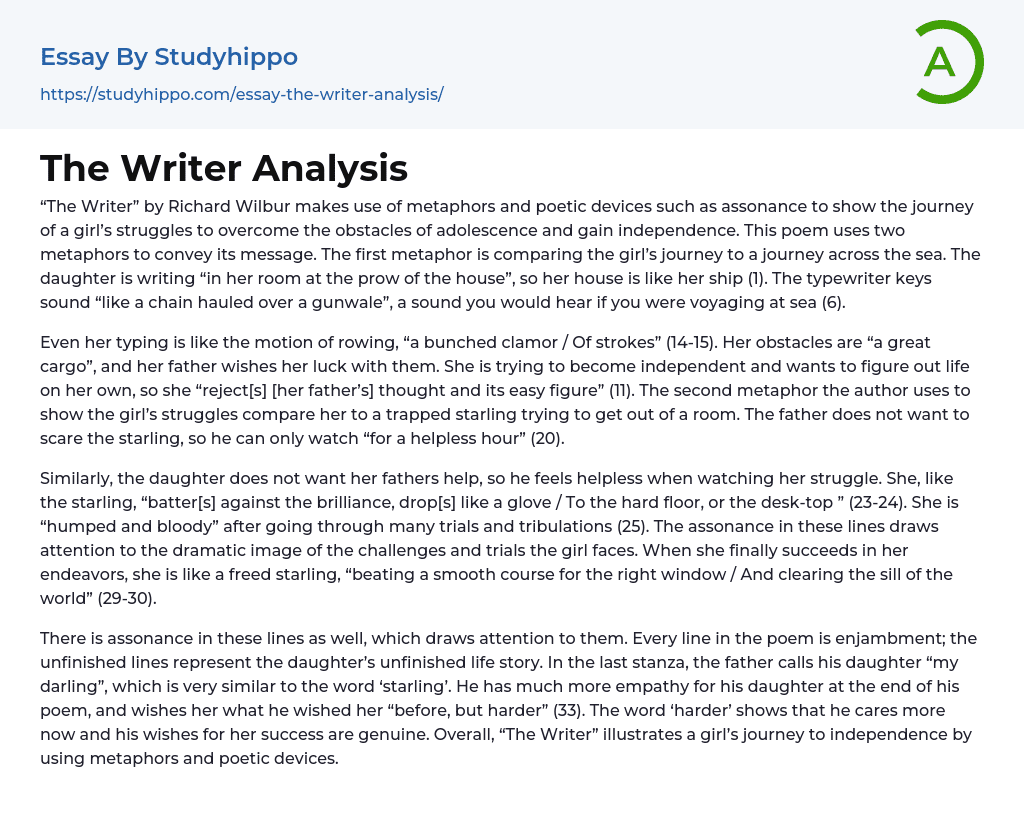“The Writer” by Richard Wilbur makes use of metaphors and poetic devices such as assonance to show the journey of a girl’s struggles to overcome the obstacles of adolescence and gain independence. This poem uses two metaphors to convey its message. The first metaphor is comparing the girl’s journey to a journey across the sea. The daughter is writing “in her room at the prow of the house”, so her house is like her ship (1). The typewriter keys sound “like a chain hauled over a gunwale”, a sound you would hear if you were voyaging at sea (6).
Even her typing is like the motion of rowing, “a bunched clamor / Of strokes” (14-15). Her obstacles are “a great cargo”, and her father wishes her luck with them. She is trying to become independent and wants to figure out li
...fe on her own, so she “reject[s] [her father’s] thought and its easy figure” (11). The second metaphor the author uses to show the girl’s struggles compare her to a trapped starling trying to get out of a room. The father does not want to scare the starling, so he can only watch “for a helpless hour” (20).
Similarly, the daughter does not want her fathers help, so he feels helpless when watching her struggle. She, like the starling, “batter[s] against the brilliance, drop[s] like a glove / To the hard floor, or the desk-top ” (23-24). She is “humped and bloody” after going through many trials and tribulations (25). The assonance in these lines draws attention to the dramatic image of the challenges and trials the girl faces. When she finally succeeds in her endeavors, sh
is like a freed starling, “beating a smooth course for the right window / And clearing the sill of the world” (29-30).
There is assonance in these lines as well, which draws attention to them. Every line in the poem is enjambment; the unfinished lines represent the daughter’s unfinished life story. In the last stanza, the father calls his daughter “my darling”, which is very similar to the word ‘starling’. He has much more empathy for his daughter at the end of his poem, and wishes her what he wished her “before, but harder” (33). The word ‘harder’ shows that he cares more now and his wishes for her success are genuine. Overall, “The Writer” illustrates a girl’s journey to independence by using metaphors and poetic devices.
- Christina Rossetti essays
- Emily Dickinson essays
- Ernest Hemingway essays
- Percy Bysshe Shelley essays
- Robert Browning essays
- Robert Louis Stevenson essays
- Seamus Heaney essays
- Carol ann duffy essays
- Anne Bradstreet essays
- Elizabeth Bishop essays
- Peter Skrzynecki essays
- Poets essays
- Robert Frost essays
- Aldous Huxley essays
- Anton Chekhov essays
- Charles Dickens essays
- Edgar Allan Poe essays
- F. Scott Fitzgerald essays
- Harper Lee essays
- Homer essays
- Jane Austen essays
- John Steinbeck essays
- Kurt Vonnegut essays
- Mark Twain essays
- Mary Shelley essays
- Nathaniel Hawthorne essays
- Sophocles essays
- Stephen King essays
- William Shakespeare essays
- Zora Neale Hurston essays
- Amy tan essays
- Virginia woolf essays
- Alice Walker essays
- Chinua Achebe essays
- Sherman Alexie essays
- George Orwell essays
- Sylvia Plath essays
- T. S. Eliot essays
- W. H. Auden essays
- Wilfred owen essays
- William blake essays
- Kate Chopin essays
- Oscar Wilde essays
- Phillis Wheatley essays
- Ray Bradbury essays
- Richard Rodriguez essays
- Walt Whitman essays
- The Tempest essays
- Leonardo Da Vinci essays
- Thomas Hardy essays




